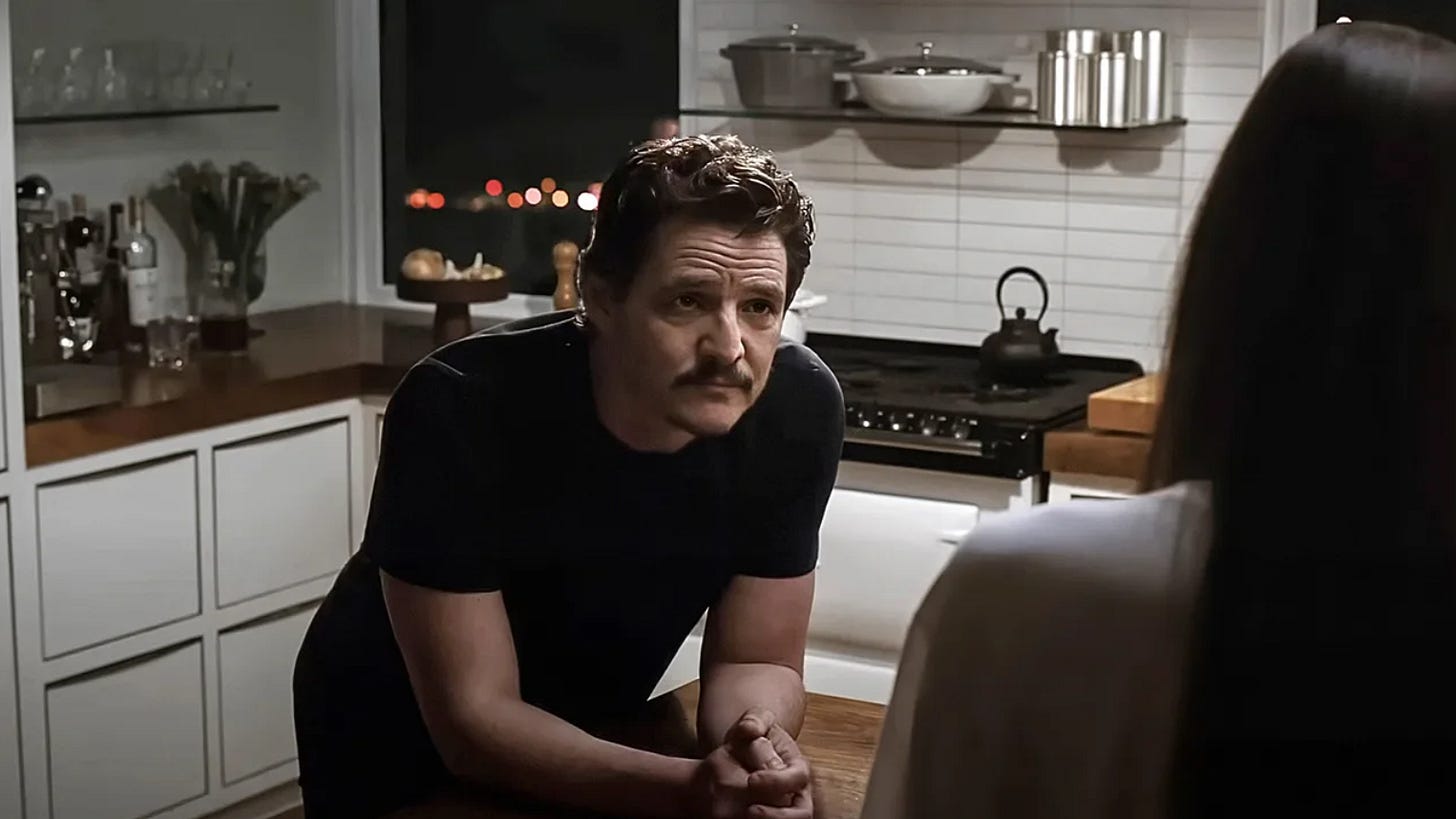Celine Song’s Materialists arrives in the aftermath of acclaim for Past Lives: this follow-up was billed as an “anti-capitalist romcom,” complete with an A24 “syllabus” of influences ranging from Broadcast News to The Age of Innocence. While reviews have been divided and wherever you land on its cinematic merits, one subplot deserves more scrutiny than it has received: the reveal that Pedro Pascal’s Harry has undergone limb-lengthening surgery to add six inches to his height.
Harry’s confession in the film is delivered without melodrama. Once 5’6”, he describes feeling invisible to women. Now, taller and smoother, he can stride into a room with the kind of confidence money usually buys. Lucy (Dakota Johnson), the professional matchmaker caught between Harry and her ex, John (Chris Evans), insists his height makes no difference to her attraction. And yet by the end, she chooses John: taller, conventionally alpha, the cultural script fully intact.
It is the neutrality with which Song treats Harry’s surgery that is striking. It is presented as one more rational investment in the marketplace of desire, akin to Lucy’s own “work” on her nose and chest. Beauty and height become capital; surgery becomes leverage. But it is at this point that the film stumbles: by not interrogating the assumption that women universally prefer taller men, Materialists ends up echoing a misogynist agenda. In manosphere and “looksmaxxing” communities, height is treated as a biological destiny. Women are framed as shallow arbiters, men as competitors forced to mutilate themselves to survive.
The data tells a very different story: Ipsos found that while two-thirds (65%) of men aged 16–24 believe women prefer taller partners, when asked what they actually value, the same age women prioritise humour (60%), kindness (53%) and honesty (49%). Only 4% rank height among their top five traits. This is pluralistic ignorance in action: people acting on what they think others want, even when those beliefs are wrong.
What Materialists dramatises is mirrored off-screen. A Guardian investigation this summer followed men travelling to Istanbul to have their legs broken and extended by a millimetre a day. The procedure is projected to be worth $8.6bn by 2030, with patients, primarily men, paying between $30,000 and $80,000 to gain a few inches. They endure months of physiotherapy, learn to walk again, and risk blood clots, nerve damage, and even death. One man, Frank, described turning the key on the rods in his femurs each day while his wife helped him on and off the toilet. His dream seems modest: to reach “average height” and be taller than his wife, but the road to getting there is harsh.
History shows this is nothing new. Chinese footbinding reshaped women’s feet for centuries to fit elite ideals. Prussia’s “Potsdam Giants” regiment prized extreme male height as a mark of national prestige. Cosmetic nose reshaping in the 19th and 20th centuries was marketed as essential for marriage prospects. Across time, myths about desirability have been reflected in bodies, painful, permanent, and always more about status than love.
But here we must consider a crucial gender-based asymmetry. Women have long endured a culture of body modification: breast augmentation, Botox, rhinoplasty, liposuction, not to mention the daily grind of dieting, waxing and make-up. These interventions are so normalised that they barely register as headline news. They are policed as “vain” or “tragic” but not treated as existential revelations. When men undergo similar modifications, however, it becomes spectacle, an object of fascination, ridicule, or pathos.
Why is this? Because masculinity has historically been constructed as “natural,” unadorned, authentic, which, in contrast to femininity, is framed as artificial, painted, and enhanced. Limb-lengthening punctures this illusion. It exposes male bodies as just as anxious, malleable, and commodified as female bodies have long been. That is why Harry’s surgery feels shocking: it forces recognition that men, too, are caught in the machinery of optimisation.
We may therefore consider this a levelling up – finally, men now get to experience what women have long lived with. But there is a difference, which is not in the act of surgery itself but in its framing. Women’s modifications have often been explained as submission to male ideals. Men’s, by contrast, are frequently narrated as competition with one another for scarce female attention, a logic that fits perfectly into manosphere discourse about “sexual marketplaces.” What is framed as individual choice is in fact gendered labour: women reshaping themselves for men; men reshaping themselves because they believe women demand it, even when women say otherwise.
But in the portrayal of Harry’s surgery as a rational choice, Materialists risks naturalising this script. Lucy may protest that height doesn’t matter, but the film’s resolution, choosing the taller man, re-inscribes the myth. In effect, it stages the manosphere’s case study: women’s stated preferences are dismissed as unreliable, while their “true” desires are confirmed through the narrative of the film.



You seem to think that women don't really care about height and other superficial metrics because of that IPSOS data you linked. Instead of looking at data from surveys (where people can inscribe their own biases), you should look at real world data, from dating apps like bumble. The data they published shows the overwhelming majority of women prefer taller men (particularly above 6 feet), and like stated in the movie, ignore short men.
You can also experiment with this yourself - create a profile with a normal looking man and mark his height as 5'6, and see how many matches you get. Try again with the exact same profile and list the height as 6'2 and you can see the difference. It's not hard.
Using that IPSOS data as proof that women don't value height is like saying that misogyny doesn't exist because you asked 1000 men if they hate women and they all said "no".
Your interpretation of this movie is hindered by the fact that you are ignorant to the reality of how superficially strict women in the modern dating sphere really are. Lucy protesting that height doesn't matter, while choosing the naturally tall man, actually reflects reality perfectly - women will lie to themselves to appear less superficial than they actually are.